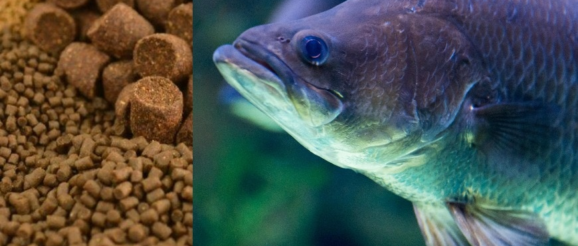Innovation helping feed Australia’s $2 billion aquaculture industry

/ By Matt Brann Australia’s aquaculture industry produces more than $2 billion worth of seafood each year, with farms around the nation growing a variety of fish species, prawns, oysters and abalone. Key points: Fish food manufacturer Ridley Corporation has reduced the amount of fishmeal and fish oil in its products It’s investigating insects as a sustainable fish pellet ingredient Australia’s largest barramundi farm is now feeding fish under cages to prevent birds from stealing feed Manufacturing the fish food for this growing industry has become big business for the ASX-listed Ridley Corporation, which owns several feed mills across Australia. Richard Smullen has been involved in Ridley’s Aquafeed operations for the last 20 years and has seen the aquaculture industry change a lot. “When I first started the diets were made up of fishmeal, fish oil, wheat and some vitamins and minerals, but nowadays we’re using a bigger range of raw materials,” he said. “We’re using less and less fishmeal and more vegetable protein, so for example we use dehulled lupins as a protein source that’s very digestible for fish.” Dr Smullen said Ridley was one of the biggest buyers of grain in Australia, with a team constantly monitoring commodity prices. “Because it’s not just fish food — we produce around two million tonnes of feed each year for every livestock animal you can think of,” he said. “We’re branching out all the time, we make a lot of dog food now and even food for laboratory rats.” What’s in fish food? According to Ridley’s annual report, the company has made significant progress in reducing “forage marine ingredients” in its products, and is using more sustainable alternatives such as chicken protein concentrate. Dr Smullen said a diverse set of raw materials was used to create fish pellets, which varied depending on the fish species. “A salmon for example has a much higher fat diet than a barramundi,” he said. “They need more energy, so we use vegetable oil or poultry oil in their pellets as fuel that salmon needs to burn.” He said the industry was increasingly looking at options to use insects. “Fish eat insects and that’s why we have fly-fishing,” he said. “Australia is a long way behind the rest of the world, but we now have some companies growing black-soldier flies, which meets the nutritional requirements for barramundi and prawns. “So we’re working with manufacturers of insect meal, it’s a growing industry, but will need to be cost-effective.” In recent years, Ridley has also partnered with the CSIRO to develop Novacq, which is now being fed to prawns throughout Australia and overseas. Innovation in feeding Australia’s largest barramundi farm is home to about five million fish, which require a lot of food. But other local creatures have taken a liking to the fish feed too. Humpty Doo Barramundi’s Dan Richards said as the farm expanded it was attracting “thousands of birds”. “We’ve tried everything to get rid of them from lasers, drones, the flappy men from the car yard, gas guns, all of these things, but it really doesn’t matter,” he said. “Once the birds realise they can get a free nutritious feed on schedule they just keep on coming back. “So we’ve developed a cage system to feed the barramundi underneath the cage, so the fish can come from underneath but the birds can’t access it from above.” Humpty Doo Barramundi now has 22 cages in ponds on the farm, which covers a bit more than 25 per cent of its production area. “We will continue to deploy cages across more of the farm as finances allow,” business services manager Tarun Richards said. “We’ve found it to be successful in reducing the amount of feed that birds can access.” Dr Smullen said he could remember when Humpty Doo Barramundi started in the 1990s and it was a great example of the “huge opportunities” in Australia to expand aquaculture. “Aquaculture is the fastest growing sector within agriculture in the world,” he said. “There’s now more farmed fish that are eaten globally than wild-caught fish. “Australians eat a huge amount of seafood … a lot of that’s imported and we could be growing it all here.”
